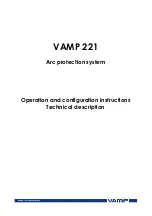
3-22
F60 Feeder Protection System
GE Multilin
3.2 WIRING
3 HARDWARE
3
APPLICATION EXAMPLE
This example is for illustrative purposes only and the calculations present the worst-case scenario. In practice, the value of
debounce time can be lower.
Contact input ON state impedance used in the calculation of the discharge period is based on the following table.
Debounce time setting = 2 ms
Assume a stray capacitance of 0.1
μ
F.
Assume an initial voltage across the stray capacitance "Vinitial" = 19 V (Vthreshold - 65 V), where Vthreshold = 84 V. The
initial voltage Vinitial depends on values of impedance of R1 and contact inputs when the contact input is OFF (non-acti-
vated state).
Therefore, discharge time constant (
τ
) =50 k
Ω
*0.1
μ
F = 5 ms.
Discharge period t is calculated from the following equation:
Vthreshold = (Vbatt - VInitial) *e^ (-t/
τ
)
84 = -149 *e^ (t/0.005)
(EQ 3.1)
T = -0.005 * ln (84/149) = 0.0029 s
Therefore, in this example the contact inputs operate.
To prevent this operation, the debounce time must be increased to 4 ms (set debounce time as per the following table) or
insert a resistor less than or equal to "R" as calculated later.
The value of this resistor "R" is calculated as follows:
1.
Determine the minimum voltage (V threshold) required to turn on the input. This is determined by direct measurement
or referenced in the input specifications.
2.
Calculate the resistance necessary to limit the voltage to 1/3 V threshold (when the contact is OFF, the non-activated
state) as follows:
R = (Vthreshold / 3) / (2 mA)
(EQ 3.2)
The 2 mA current is used in case the contact input is connected across the GE Form A contact output with voltage
monitoring. Otherwise use the amperage of the active circuit connected to the contact input when its contact output is
open and the voltage across the contact input is third trigger threshold to calculate the resistor value.
3.
When the contact is ON (operate state), the battery voltage appears across the resistor. The wattage rating of the
resistor is then:
PR = 1.3 * (Vbatt) ^2 / R Watts
(EQ 3.3)
4.
Applying the following equation to our example:
R = 84 V / 3*(1 / 2 mA) = 14 k
Ω
PR = 1.57 Watts
(EQ 3.4)
5.
Calculating the voltage across the contact input with the Burden Resistor, Voltage across the contact Input:
Table 3–3: DISCHARGE PERIOD
BATTERY VOLTAGE (V)
INPUT IMPEDANCE (K
Ω
)
130
50
250
97
Table 3–4: TYPICAL DEBOUNCE TIME SETTING
STRAY CAPACITANCE (
μ
F)
BATTERY VOLTAGE (V)
DEBOUNCE TIME (MS)
0.05
130
2
0.1
130
4
0.2
130
6
0.05
250
3
0.1
250
6
0.2
250
11
Summary of Contents for F60
Page 10: ...x F60 Feeder Protection System GE Multilin TABLE OF CONTENTS ...
Page 30: ...1 20 F60 Feeder Protection System GE Multilin 1 5 USING THE RELAY 1 GETTING STARTED 1 ...
Page 138: ...4 28 F60 Feeder Protection System GE Multilin 4 2 FACEPLATE INTERFACE 4 HUMAN INTERFACES 4 ...
Page 454: ...5 316 F60 Feeder Protection System GE Multilin 5 10 TESTING 5 SETTINGS 5 ...
Page 500: ...7 14 F60 Feeder Protection System GE Multilin 7 1 COMMANDS 7 COMMANDS AND TARGETS 7 ...
Page 508: ...8 8 F60 Feeder Protection System GE Multilin 8 2 FAULT LOCATOR 8 THEORY OF OPERATION 8 ...
Page 522: ...10 12 F60 Feeder Protection System GE Multilin 10 6 DISPOSAL 10 MAINTENANCE 10 ...
Page 660: ...B 116 F60 Feeder Protection System GE Multilin B 4 MEMORY MAPPING APPENDIX B B ...
Page 706: ...E 10 F60 Feeder Protection System GE Multilin E 1 IEC 60870 5 104 APPENDIX E E ...
Page 718: ...F 12 F60 Feeder Protection System GE Multilin F 2 DNP POINT LISTS APPENDIX F F ...
Page 728: ...H 8 F60 Feeder Protection System GE Multilin H 2 ABBREVIATIONS APPENDIX H H Z Impedance Zone ...
Page 730: ...H 10 F60 Feeder Protection System GE Multilin H 3 WARRANTY APPENDIX H H ...
















































